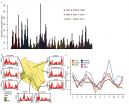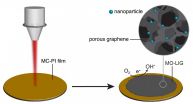(Press-News.org) Scientists have exposed a chink in the armour of disease-causing bugs, with a new discovery about a protein that controls bacterial defences.
Bacteria react to stressful situations - such as running out of nutrients, coming under attack from antibiotics or encountering a host body's immune system - with a range of defence mechanisms. These include constructing a resistant outer coat, growing defensive structures on their surface or producing enzymes that break down the DNA of an attacker.
The new research shows that a protein called sigma54 holds a bacterium's defences back until it encounters stress, at which point the protein rearranges its structure to trigger the defences into action. The range of defences that sigma54 controls is so broad that the scientists are moving quickly to learn how to block its action and disable some of the bacteria's armour.
The findings of the study are published today [see embargo] in the journal Science by researchers at Imperial College London with collaborators at Peking University in China, Pennsylvania State University and University of Wisconsin-Madison, in the USA.
Scientists already knew of sigma54's existence but in the new research, the team used the UK's national synchrotron facility - Diamond Light Source, based in Oxfordshire - to explore sigma54's structure and function in minute detail.
A cellular machine called RNA polymerase (RNAP) is essential for enabling bacteria to function. In the study, the team used the advanced capabilities at Diamond's Membrane Protein Laboratory to see for the first time how sigma54 directs RNAP to sit on the bacterial DNA, where it is poised to build the bacteria's defences.
The RNAP-sigma54 complex can only work when it is activated and the scientists have long been trying to find out how sigma54 keeps RNAP in check, at a molecular level. They hope that ultimately, understanding how RNAP is controlled could lead to new ways of disabling bacterial defence mechanisms, and to new compounds that can kill bacteria.
Lead author Professor Xiaodong Zhang, from the Centre for Structural Biology and Department of Medicine at Imperial College London, said: "Bacteria are increasingly developing resistance to antibiotics and with the rise of resistant strains of bacteria that cause diseases like tuberculosis, we desperately need to find new ways of tackling this problem.
"The RNAP machine is absolutely essential for a bacterium to function and in our new research we have uncovered multiple strategies that sigma54 uses to silence it. If we can find ways to harness sigma54's ability to control bacteria's defences, we can potentially inhibit bacteria from functioning normally, or prevent them from defending themselves. We are in the early stages of this research but if we are ultimately successful, we could give medicine the upper hand again," she added.
Co-author Professor Martin Buck, from the Department of Life Sciences at Imperial College London, said, "Many important bacteria, such as Salmonella and Klebsiella, rely on this mechanism to trigger their stress responses and defences, which makes the prospect of manipulating it all the more tantalising. The use of sigma-54 and RNAP together to control the defences appears to be a very ancient but sophisticated strategy to control gene expression."
This research was funded by the UK's Biotechnology and Biological Sciences Research Council (BBSRC) over the last four years, and following the publication of these findings a grant has been awarded from the Medical Research Council (MRC) to explore controlling genes in pathogenic bacteria, including Salmonella and Klebsiella.
The structure of the protein was determined by experiments at Diamond Light Source, where Imperial jointly runs the Membrane Protein Laboratory in partnership with Diamond. The cutting-edge laboratory is a research and training facility for scientists interested in solving the 3D structures of membrane proteins by X-ray crystallography.
INFORMATION:
The majority of the work was funded by the Biotechnology and Biological Sciences Research Council, with further support from the Chinese National Science Foundation, the China Scholarship Council and the National Institutes of Health.
WEST LAFAYETTE, Ind. -- Results of the XENON100 experiment are a bright spot in the search for dark matter.
The team of international scientists involved in the project demonstrated the sensitivity of their detector and recorded results that challenge several dark matter models and a longstanding claim of dark matter detection. Papers detailing the results will be published in upcoming issues of the journals Science and Physical Review Letters.
Dark matter is an abundant but unseen matter in the universe considered responsible for the gravitational force that keeps the ...
Scientists studying the 2009 A/H1N1 influenza pandemic have found that the inconsistent regional timing of pandemic waves in Mexico was the result of interactions between school breaks and regional variations in humidity.
The research published in PLOS Computational Biology, led by Dr. James Tamerius at the University of Iowa and Dr. Gerardo Chowell at Georgia State University, applied mathematical models to understand the social and environmental processes that generated two distinct pandemic outbreaks ("waves") in Mexico during the summer and fall of 2009.
The summer ...
Children who have been abused or exposed to other types of trauma typically experience more intense emotions than their peers, a byproduct of living in volatile, dangerous environments.
But what if those kids could regulate their emotions? Could that better help them cope with difficult situations? Would it impact how effective therapy might be for them?
A University of Washington-led team of researchers sought to address those questions by studying what happens in the brains of maltreated adolescents when they viewed emotional images, and then tried to control their ...
PRINCETON, N.J.--Tracking mobile phone data is often associated with privacy issues, but these vast datasets could be the key to understanding how infectious diseases are spread seasonally, according to a study published in the Proceedings of the National Academy of Sciences.
Princeton University and Harvard University researchers used anonymous mobile phone records for more than 15 million people to track the spread of rubella in Kenya and were able to quantitatively show for the first time that mobile phone data can predict seasonal disease patterns.
Harnessing ...
Glenview, Ill. (August 20, 2015)--The popularity of electronic cigarettes has steadily increased worldwide, but little is known about their effects on health. New research suggests that the single use of an electronic cigarette approximating the nicotine exposure of one tobacco cigarette reduces the sensitivity of the cough reflex.
The study tested 30 adult lifetime nonsmokers with no history of asthma or respiratory diseases and used cough tests to determine how e-cigarettes affect the cough reflex. Capsaicin, the pungent extract of red peppers, was used to induce a ...
Medicaid is expected to save billions of dollars a year as patents for several blockbuster antipsychotic medications expire and use of generic versions of these drugs increases, according to a new study by researchers at the University of Maryland School of Medicine. These savings may provide relief from the high costs of these medications and allow policymakers to lift restrictions on patients' access, the researchers argue.
The study forecast that annual Medicaid payments for antipsychotic medicines will decrease by nearly $1.8 billion (or nearly 50 percent) by 2016 ...
HOUSTON - (Aug. 20, 2015) - Rice University chemists who developed a unique form of graphene have found a way to embed metallic nanoparticles that turn the material into a useful catalyst for fuel cells and other applications.
Laser-induced graphene, created by the Rice lab of chemist James Tour last year, is a flexible film with a surface of porous graphene made by exposing a common plastic known as polyimide to a commercial laser-scribing beam. The researchers have now found a way to enhance the product with reactive metals.
The research appears this month in the ...
Leading scientists and experts in the field of rhino conservation state in a new paper that it is safe to consider the Sumatran rhinoceros extinct in the wild in Malaysia. The survival of the Sumatran rhino now depends on the 100 or fewer remaining individuals in the wild in Indonesia and the nine rhinos in captivity.
Despite intensive survey efforts, there have been no signs of the wild Sumatran rhinoceros (Dicerorhinus sumatrensis) in Malaysia since 2007, apart from two females that were captured for breeding purposes in 2011 and 2014. Scientists now consider the species ...
An international team of scientists headed by biologists at UC San Diego has discovered that an important class of stem cells known as human "induced pluripotent stem cells," or iPSCs, which are derived from an individual's own cells, can be differentiated into various types of functional cells with different fates of immune rejection.
The scientists also found that these cells may not be rejected by the immune system if iPSCs are turned into retinal pigment epithelium cells destined for the eye.
Their discovery provides hope for the development of human stem cell therapies ...
A team of Swiss geneticists from the University of Geneva (UNIGE), the École Polytechnique Fédérale de Lausanne (EPFL), and the University of Lausanne (UNIL) discovered that genetic variation has the potential to affect the state of the genome at many, seemingly separated, positions and thus modulate gene activity, much like a conductor directing the performers of a musical ensemble to play in harmony. These unexpected results, published in Cell, reveal the versatility of genome regulation and offer insights into the way it is orchestrated.
Chromatin, a ...


